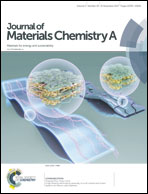A flexible all inorganic nanowire bilayer mesh as a high-performance lithium-ion battery anode†
Abstract
Herein, we report a flexible, binder-free inorganic nanowire bilayer mesh as a lithium-ion battery anode that provides high practical areal, gravimetric, and volumetric capacities. The configuration of the binder-free inorganic nanowire bilayer mesh anode is solely composed of two layers of nanowire fabric with one layer of germanium (Ge) nanowires and the other of copper nanowires. This nanowire electrode exhibited a high specific capacity of 1153 mA h g−1 when cycled at 0.1C, good rate-capability (359 mA h g−1 at a charge current density of 20 A g−1, 20C), and long-term cycling life of 1000 cycles and 1300 cycles when operated at 1C and 10C (discharge rate was fixed at 1C), respectively. The tightly tangled bilayer Ge/Cu nanowire mesh provides not only a strong structure to prevent the detachment of active materials, but also better electrical conduction because the two layers of nanowires penetrate each other instead of making a clear boundary. Moreover, the loading of Ge nanowires on a 1 cm2 Cu nanowire mesh is tunable within a wide range from 0.5 to 6 mg, corresponding to high areal capacities from 0.5 to 6 mA h cm−2 and volumetric capacity from 217 to 539 mA h cm−3, which is nearly twice as high as that of commercial graphite anodes with one side coating (255 mA h cm−3) and 10 times higher than those of reported Ge flexible electrodes made with CNFs. A full-cell battery with a capacity of 60 mA h composed of a Ge/Cu fabric anode and Li(Ni0.5Co0.3Mn0.2)O2 cathode was assembled to power up a power tool and LED arrays; this provided a proof-of-concept example to implement the nanowire mesh structure into a current battery system.



 Please wait while we load your content...
Please wait while we load your content...